German Gold Demand "Spikes"- Investment Demand Surges 63%
Commodities / Gold and Silver 2015 May 15, 2015 - 05:11 PM GMTBy: GoldCore
 - Global gold demand marginally lower but robust – WGC
- Global gold demand marginally lower but robust – WGC
- Gold investment demand surges 63% as jewellery demand falls
- German gold demand spikes 20% in first quarter
- France, Switzerland and Austria see “double digit” rise in demand
- Fear of conflict with Russia, ‘Grexit’ and currency debasement
- Indian gold demand rises 15%
- Germany knows lessons of history and Weimar hyperinflation
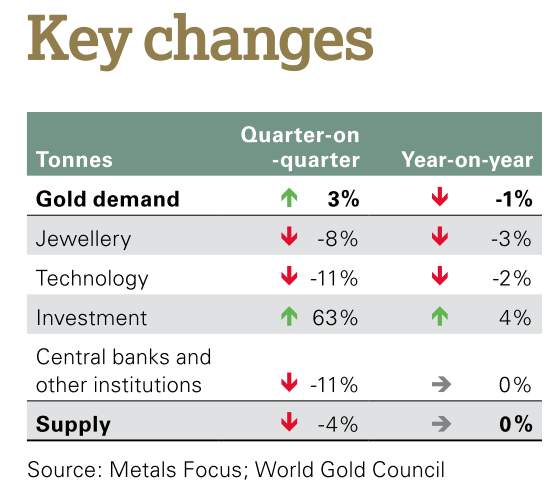
Global gold demand remains robust as seen in the latest quarterly figures from the World Gold Council released yesterday. Q1, 2015 gold demand was just 1% lower year on year but was 3% higher quarter on quarter due to a surge in investment demand which was 4% higher year on year and a whopping 63% surge in investment demand quarter on quarter.
European investors increased their purchases of gold during the first quarter according to the report. Increase in demand was highest in Germany while investors in France, Switzerland and Austria also showed strong interest in acquiring the precious metal, with double digit increases in demand.
The WGC says that German demand for gold coins and bars “spiked” by 20% in the first quarter of 2015 compared to the same period last year.
CNN reported that it is unusual that there should be such strong demand out of Germany given the strength of the economy.
Although this ignores the strong cultural affinity that Germans have with gold and the fact that they are consistently, along with the Austrians and Swiss, the largest buyers of gold in Europe. What has changed is that more German people are buying gold and they are buying larger amounts due to the various risks challenging Europe and indeed the world.
France, Switzerland and Austria all saw strong demand for gold and it is known that in Greece, demand for gold bullion storage and gold sovereigns in particular was strong too during the quarter.
The first quarter saw the exacerbation of the Greek crisis with the election of Syriza, the initiation of QE by the ECB, massive currency volatility with the breaking of the Swiss Franc peg to the Euro, the failure of Austria’s bad bank and very tense relations between the West and Russia over Ukraine.
“The first three months of 2015 represented the strongest start to a year for European gold demand since 2011” when the European sovereign debt crisis was at its peak.
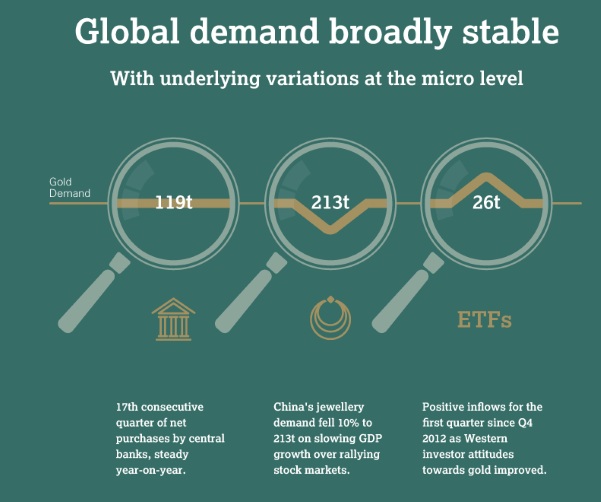
Gold Demand Trends Q1 2015 – World Gold Council
Germans are very concerned about inflation, currency debasement and devaluation due to Mario Draghi’s QE program. Germany had put up strong resistance to ECB euro ‘printing’ but in the end the ECB prevailed when Germany was assured it would not be liable for less reliable government bonds bought by other central banks.
Italian banker Mario Draghi said yesterday that the quantitative program has “proven so far to be potent, more so than many observers anticipated.” At a speech to the IMF at headquarters in Washington the ex-Goldman banker said that “while we have already seen a substantial effect of our measures on asset prices and economic confidence, what ultimately matters is that we see an equivalent effect on investment, consumption and inflation.”
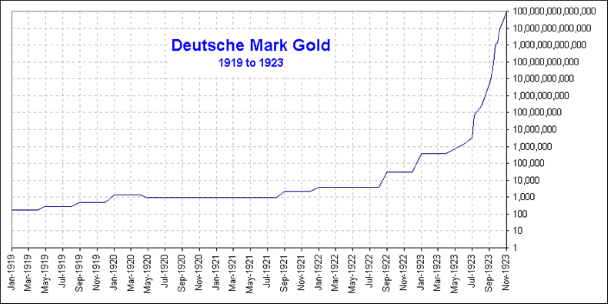
Draghi’s QE has not achieved any of its stated objectives. His pronouncement that it has been “potent” is therefore premature. History offers no assurances that these objectives will be met.
Indeed, even very recent history is not assuring. QE in Japan and in the U.S. has had little effect on the real economy. The primary beneficiaries, as Alan Greenspan recently pointed out, were the super-rich for whom it was a “terrific success.”
The fact that QE in the U.S. has not yet led to high inflation is not proof that it cannot happen. The Fed’s balance sheet is still bloated and we will not be in a position to judge the efficacy of the experiment until it has been fully wound down – if it ever is. Indeed, the recent string of poor economic data out of the U.S. suggests that rather than interest rate rises, the Fed may be forced to embark on QE4.
German are rightly concerned about currency debasement of the world’s reserve currency and indeed of all reserve and major currencies today including the euro. Some dismiss this concern as Germans being ‘paranoid’ about inflation. This is not fair to the Germans and shows a complete lack of awareness of history and the risks of currency debasement.
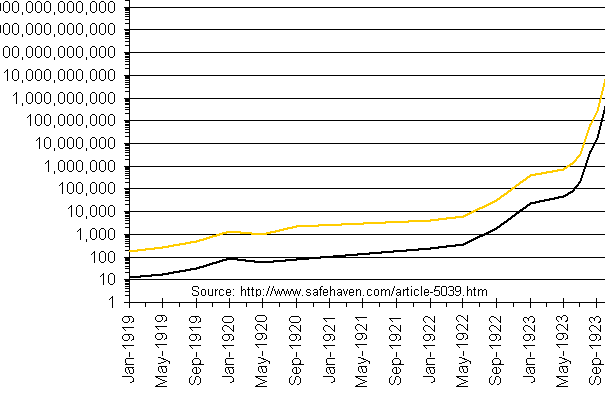
It also shows a huge complacency and the dangerous thinking of this is a “new paradigm” and “this time is different.” This time is never different and the Germans know this.
Psychological scars were inflicted by the epic hyperinflation experienced by Germany in the Weimar Republic – a hyperinflation caused by unlimited currency creation by a desperate central bank. Germans have learnt the lessons of history – unlike many other nations today.
It is worth recalling the Germans experience of hyperinflation. In January of 1919 a single ounce of gold could be purchased for 170 Marks. Within a year the price had increased almost eightfold as currency printing devalued the Mark to over 1,000 Marks per ounce.
The price stabilised over the next year and then doubled in 1921 before surging over 9,300% throughout 1922.
With each passing year the currency fell in value to ever more absurd depths until by November 1923 an ounce of gold – which had cost 170 Marks only five years previously – was trading at 87,000,000,000,000 Marks per ounce.
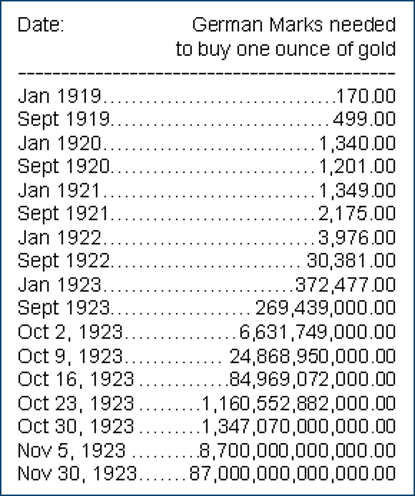
Silver saw similar price gains – or rather to put it more accurately silver too remained a store of value and maintained purchasing power as the currency collapsed.
The bitter hardship and instability arising out of this experiment by people who believed they knew best was only ‘stabilised’ by the fascist war machine and the rise of Hitler and the Nazis which resulted in further economic hardship and collapse after their defeat in World War II – largely at the hands of the Russians.
The Weimar experience teaches us the value of owning money that cannot be created out of thin air by government decree. The Germans have learnt this lesson.
It is ironic that the people living in the strongest economy in the EU and the one with the best outlooks are buying more gold than people in much more vulnerable countries. Gold buying in Ireland, Portugal, Spain and Italy remains very low despite people in these economies being even more exposed to financial risk than the Germans.
Before some market commentator decides to attack us and call us gold “bugs” who are predicting hyperinflation, let us qualify. We are not predicting hyperinflation.
We feel it is important to look at history and to acknowledge that hyperinflation is a possibility – especially if central banks continue to debase currencies en masse. Currently, it remains a low possibility, however what is a strong possibility and indeed is something we view as inevitable is very significant inflation and stagflation in the coming years and hence the need to own physical gold and silver in secure vaults internationally.
One of the most successful fund managers in the world, Ray Dalio, addressing the influential Council on Foreign Relations about gold, recently said, “it’s not sensible not to own gold”. He added, “there is no sensible reason other than you don’t know history and you don’t know the economics of it”.
He described gold as a currency comparable to the dollar or yen or euro and suggested that investors hold 10% of their savings in physical gold.
Gold Demand Trends Q1 2015 – World Gold Council
Storing Gold? 7 Key Must Haves – GoldCore
MARKET UPDATE
Today’s AM LBMA Gold Price was USD 1,216.30, EUR 1,071.23 and GBP 772.95 per ounce.
Yesterday’s AM LBMA Gold Price was USD 1,214.75, EUR 1,063.59 and GBP 768.91 per ounce.
This week, gold and silver are 2.5 and 5.8 per cent higher respectively and indeed gold and silver has seen gains in all major currencies.
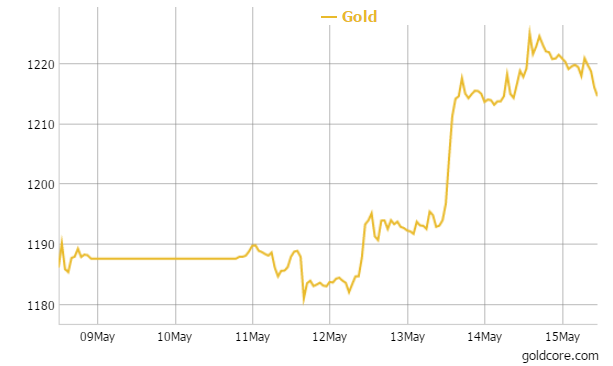
Gold in USD – 1 Week
Gold consolidated on Wednesday’s strong gains yesterday and rose $7.00 or 0.58 percent to $1,221.80 an ounce, and silver climbed another $0.32 or 1.87 percent to $17.43 an ounce.
Gold in Singapore near the end of day trading was steady at $1,220.70 an ounce. Gold hovered near a 3 month high today and looks on track for its largest weekly gain in four months as economic data point to a sluggish U.S. economy and a likely delay in the U.S. Fed’s interest rate hike.
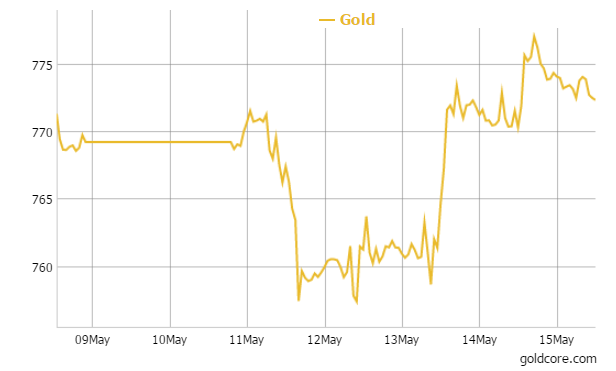
Gold in GBP – 1 Week
The weekly gains in all major currencies and the strong move through the resistance at the 100 day and the 200 day moving averages (sma) is bullish technically and bodes well for next week
Gold surged through its 100-day moving average at $1,210 per ounce like a knife through butter on Wednesday after it rallied sharply on the poor retail sales. The 100 day moving average was a level it hasn’t managed to convincingly break above since mid February. Gold continued its gains and then rose above the 200 day sma at $1,218.50 and it closed above that level again yesterday at $1,221.80 per ounce.
Premiums in Asia have pulled back a bit but are still selling above the global benchmark rate by $1 an ounce. All the data shows that demand in China and India remains very robust.
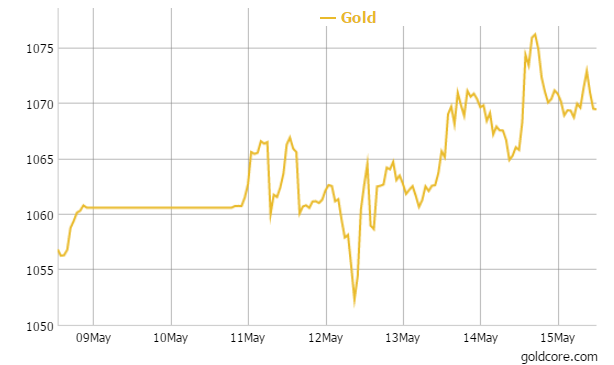
Gold in EUR – 1 Week
India, the world’s biggest gold consumer, has imported 60 tonnes of bullion in the first two weeks of May alone, Bloomberg TV reported on Friday quoting India’s Revenue Secretary, Shaktikanta Das.
The country imported a very robust 111 tonnes in April as it celebrated the key Akshaya Tritiya festival, when it is considered auspicious to buy gold, the channel reported, quoting Das.
Global gold demand eased 1 percent in the first quarter, the WGC have reported as a drop in Chinese jewellery demand narrowly outweighed a recovery in Indian buying and Western appetite for bullion-backed funds.
India’s total gold demand rose 15 percent to 192 tonnes in the first quarter, WGC’s quarterly demand report showed.
Silver’s nearly 6 per cent gains means that it is set for its biggest weekly gain in two months. Platinum is on track for a third consecutive weekly gain, but palladium looks to have a weekly decline.
In late European trading gold is down 0.37 percent at $1,216.46 an ounce. Silver is off 1.20 percent at $17.29 an ounce and platinum is down 0.41 percent at $1,154.00 an ounce.
The yellow metal is being supported by jittery bond markets, rising bond yields and dollar weakness this week.
Recent economic data, including the retail sales number yesterday, has been more negative than positive. This is contributing to volatility in bond markets and some selling pressure in equity markets There are increasing concerns about the economic outlook globally.
This update can be found on the GoldCore blog here.
Mark O'Byrne
Director
IRL |
UK |
IRL +353 (0)1 632 5010 |
WINNERS MoneyMate and Investor Magazine Financial Analysts 2006
Disclaimer: The information in this document has been obtained from sources, which we believe to be reliable. We cannot guarantee its accuracy or completeness. It does not constitute a solicitation for the purchase or sale of any investment. Any person acting on the information contained in this document does so at their own risk. Recommendations in this document may not be suitable for all investors. Individual circumstances should be considered before a decision to invest is taken. Investors should note the following: Past experience is not necessarily a guide to future performance. The value of investments may fall or rise against investors' interests. Income levels from investments may fluctuate. Changes in exchange rates may have an adverse effect on the value of, or income from, investments denominated in foreign currencies. GoldCore Limited, trading as GoldCore is a Multi-Agency Intermediary regulated by the Irish Financial Regulator.
GoldCore is committed to complying with the requirements of the Data Protection Act. This means that in the provision of our services, appropriate personal information is processed and kept securely. It also means that we will never sell your details to a third party. The information you provide will remain confidential and may be used for the provision of related services. Such information may be disclosed in confidence to agents or service providers, regulatory bodies and group companies. You have the right to ask for a copy of certain information held by us in our records in return for payment of a small fee. You also have the right to require us to correct any inaccuracies in your information. The details you are being asked to supply may be used to provide you with information about other products and services either from GoldCore or other group companies or to provide services which any member of the group has arranged for you with a third party. If you do not wish to receive such contact, please write to the Marketing Manager GoldCore, 63 Fitzwilliam Square, Dublin 2 marking the envelope 'data protection'
GoldCore Archive |
© 2005-2022 http://www.MarketOracle.co.uk - The Market Oracle is a FREE Daily Financial Markets Analysis & Forecasting online publication.



